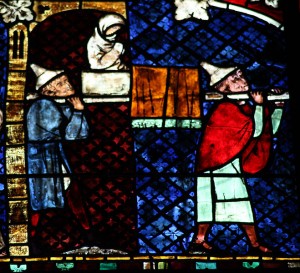Luke 13:10-17
This text is used for the Lectionary Year C on August 21, 2016.

This passage carries us into a synagogue where Jesus is teaching. By this point in Luke’s gospel narrative, Jesus’ reputation in the region was established. Jesus had performed several dramatic healings and exorcisms, fed the five thousand, and taught burgeoning crowds in cities and villages. Jesus stands and teaches, and those seeking healing have followed him.
The passage draws the audience into a moment when they are witnessing a dramatic act of compassion and healing. The gospel narratives most often portray those seeking healing as calling out and demanding Jesus’ attention. This, however, is a very different encounter. The nameless woman appears to have neither said nor done anything to draw Jesus’ attention. Jesus sees the woman, has compassion on her, and reaches out to her.
The woman had been bent and crippled, struggling in every move in every moment. Then, in a word her world is changed. Luke reports, “When he laid his hands on her, immediately she stood up straight and began praising God” (v. 13). She was surrounded by her friends and community of faith. One would think everyone would rejoice with her, yet a voice of objection calls out.
The objection comes from the leader of the synagogue. He is indignant about Jesus’ healing on the Sabbath. His objection is not to the healing itself, but to its timing. In healing the woman, the leader contended, Jesus had broken the Sabbath rules. Those who had gathered to be healed were equally complicit because they could have come on any other day of the week to be healed. As the leader lays out his argument, contending that Jesus did the right thing at the wrong time, making it the wrong thing. It is important to note that violating the Sabbath was more than breaking a petty religious law. The command to keep the Sabbath holy is at the heart of Judaism and is pronounced as one of the Ten Commandments given to Moses for the people (Exodus 20:8). The observance of the Sabbath is central to the set-apartness which shaped the Jewish people’s identity as the people of God. Violation of the Sabbath violated who they were in relationship with God and others.
This is not the first time Jesus had to deal with disapproval regarding his and his disciples’ actions on the Sabbath. The Gospel of Luke records a parallel narrative in Chapter 6 in which Jesus is in conflict with religious leadership because he heals the man with the withered hand on the Sabbath. (Note synoptic parallels in Mark 3 and Matthew of the synagogue’s leadership. In this passage Jesus boldly proclaims, “The Son of Man is lord of the Sabbath” (6:5). This perspective shapes both Jesus’ view of the Sabbath and what might be acceptable actions on the Sabbath.
In response to the leader of the synagogue, Jesus begins where he and the man find common ground regarding actions permissible on the Sabbath. However, Jesus almost instantly reshapes the conversation. Jesus parallels caring for a work animal with healing the woman by leveraging a specific term for the woman; he calls her a “daughter of Abraham” (6:16). By using this phrase, Jesus is elevating his healing the woman over the other permissible Sabbath acts. If one can care for a thirsty ox, then certainly one should be able to care for a woman who is a fellow heir of the blessing promised to Abraham. Jesus clarifies that a valued child of God was bound and wounded, and the right act is love and compassion, regardless of time or place.
This text invites several different approaches to a sermon. One option is to invite the congregation to consider with whom they might best identify in the story. While most would probably guess they are supposed to identity with the person Jesus heals, doing so is not that easy. In an established church culture, the phrases “we’ve always done it that way” or “we’ve never done it that way before” are prevalent in church hallways. It is easy to preserve the institutional church and its traditions at the expense of what might be healing or redemptive. It can also be more comfortable to identify with the leader of the synagogue. Taking on the woman’s identity can cause us to embrace our need for healing and accept that, apart from an act of Jesus, we will remain broken and bent. This is a humbling stance for a culture that embraces self-reliance as a core value.
An alternative approach is to focus on how Jesus reached out and healed a woman who had neither spoken nor acted in a fashion to draw Jesus’ attention. Our communities are filled with those suffering in silence or obscurity who need to be loved and healed through Christ’s work as expressed through the Church. An ongoing issue for the Church is that it can become so focused on sustaining the institution that it overlooks those in need of the Church. This passage is a call to see people with eyes of love and compassion and become instruments of healing and grace.
 Tom Ogburn
Tom Ogburn
Senior Pastor
First Baptist Church, Knoxville, Tennessee
togburn@fbcknox.org
Tags: healing on the Sabbath, daughter of Abraham, healing, crippled, compassion, pharisee
